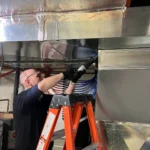Introduction to HVAC Sizing
Proper HVAC sizing is essential for achieving optimal home comfort. When your HVAC system is sized correctly, it efficiently heats and cools your home, keeping the temperature consistent and comfortable throughout the year. On the other hand, an improperly sized HVAC unit can lead to discomfort, increased energy bills, and long-term wear and tear on the system itself. Many homeowners make the mistake of thinking bigger is better or that a smaller system will save money. However, the truth is that HVAC sizing must be precisely calculated to ensure both efficiency and comfort.
What is HVAC Sizing?
HVAC sizing refers to determining the correct capacity of a heating, ventilation, and air conditioning system based on the needs of the home. This calculation takes into account several factors, including the square footage of the house, insulation levels, window size and placement, local climate, and the number of occupants. The goal is to select an HVAC unit that can maintain a comfortable temperature without using more energy than necessary. HVAC sizing is not just about the physical size of the unit but also about the power and capacity required to meet the heating and cooling demands of your home.
Common HVAC Sizing Mistakes
One of the most common mistakes homeowners make is selecting an HVAC system that is too large, assuming it will provide better performance. In reality, an oversized HVAC unit can cause a host of issues. When a system is too large for a home, it tends to cycle on and off frequently, known as short cycling. This not only leads to uneven temperatures but also increases wear and tear on the system, resulting in a shorter lifespan and higher maintenance costs. Conversely, an undersized HVAC system may struggle to keep up with the demand, running constantly but failing to achieve the desired temperature. This increases energy consumption and results in higher utility bills.
Oversized HVAC Systems: Why Bigger Isn’t Always Better
An oversized HVAC system can cause a range of problems, many of which are counterintuitive to what homeowners expect. Because larger units cool or heat a space quickly, they tend to turn off before they have had a chance to properly regulate the temperature. This results in inconsistent temperatures throughout the home, with some rooms being too hot or too cold. Additionally, oversized systems tend to have trouble with humidity control, as they do not run long enough to dehumidify the air effectively. This can leave your home feeling sticky and uncomfortable, particularly in humid climates.
Short cycling also takes a toll on the system’s components, causing them to wear out faster than they would in a properly sized system. The constant starting and stopping increase the risk of system failure and require more frequent maintenance. Over time, the inefficiency of an oversized system leads to increased energy consumption, higher utility bills, and a shortened lifespan for the unit.
Undersized HVAC Systems: The Strain on Efficiency
While an oversized system comes with its own set of problems, an undersized HVAC unit presents an entirely different challenge. A system that is too small for the home will struggle to meet the heating and cooling demands placed on it. This means the system will run continuously, trying to maintain a comfortable temperature but never quite getting there. The result is uneven heating and cooling, particularly during extreme weather conditions.
The constant strain placed on an undersized HVAC system leads to inefficiency and excessive energy use. Because the system is working overtime to try to achieve the desired temperature, it consumes more energy than it should, leading to higher utility bills. In addition, the system’s components experience more wear and tear, resulting in frequent repairs and a shorter lifespan. An undersized system can also fail to adequately control humidity, further diminishing home comfort.
The Link Between HVAC Sizing and Efficiency
HVAC efficiency is directly tied to proper sizing. When a system is sized correctly, it operates within its optimal efficiency range, consuming less energy to maintain a comfortable indoor environment. This not only reduces energy bills but also minimizes the environmental impact of your home’s heating and cooling system. A well-sized system is better equipped to handle temperature fluctuations and extreme weather, maintaining a stable and comfortable temperature year-round.
An improperly sized system, on the other hand, works harder than it needs to, either running continuously or short cycling. Both scenarios lead to increased energy consumption and reduced efficiency. HVAC systems are designed to operate at peak efficiency when they run for longer periods without cycling on and off repeatedly. A correctly sized system will reach the desired temperature gradually, maintaining it consistently with minimal energy use.
How Insulation Affects HVAC Sizing
Insulation plays a critical role in determining the size of the HVAC system needed for your home. Well-insulated homes retain heat in the winter and stay cooler in the summer, reducing the amount of work your HVAC system has to do. Proper insulation lowers the overall heating and cooling load, allowing for a smaller, more efficient HVAC unit. On the other hand, homes with poor insulation lose heat in the winter and gain it in the summer, requiring a larger system to compensate.
When calculating the appropriate HVAC size, contractors assess the insulation levels in your home to ensure that the system is neither too large nor too small. Upgrading your insulation can improve the efficiency of your HVAC system, as the unit won’t have to work as hard to maintain a comfortable temperature. This reduces energy consumption and lowers utility bills, all while improving home comfort.
The Influence of Climate on HVAC Sizing
Climate is another significant factor that impacts HVAC sizing. Homes in colder regions require systems with greater heating capacity, while those in warmer climates need more powerful cooling systems. Additionally, homes in areas with high humidity need HVAC systems that can handle moisture control as well as temperature regulation. Failure to account for the local climate when sizing an HVAC system can result in a unit that struggles to meet the demands placed on it during extreme weather conditions.
For instance, homes in hot, dry climates may require a larger air conditioning unit to maintain comfort during the hottest months of the year. Conversely, homes in cold climates need systems that can provide enough heat to keep the space warm even during freezing temperatures. Climate considerations are an essential part of the HVAC sizing process and must be carefully evaluated to ensure the system is equipped to handle the demands of the local environment.
Why Regular Maintenance Matters for Properly Sized HVAC Systems
Even the most well-sized HVAC system requires regular maintenance to perform at its best. Over time, filters can become clogged, coils can become dirty, and mechanical components can wear out, reducing the efficiency of the system. Without proper maintenance, a perfectly sized system can become inefficient, leading to increased energy consumption and reduced comfort.
Regular maintenance tasks like changing air filters, cleaning condenser coils, and inspecting ductwork help ensure that the system is running smoothly. In addition, professional inspections can identify potential issues before they become major problems, allowing for timely repairs and preventing costly breakdowns. A well-maintained HVAC system operates more efficiently, uses less energy, and lasts longer, providing better overall value for homeowners.
The Environmental Impact of Proper HVAC Sizing
Choosing the right size HVAC system not only improves home comfort and efficiency but also has a positive impact on the environment. Oversized systems waste energy through frequent cycling, while undersized systems consume excessive energy by running continuously. By selecting a properly sized HVAC system, homeowners can reduce their carbon footprint and contribute to energy conservation efforts.
Additionally, a well-sized system places less strain on the electrical grid, particularly during peak demand periods. This helps reduce the overall demand for energy production, lowering greenhouse gas emissions and promoting a more sustainable future. HVAC systems that operate efficiently also use fewer natural resources, making proper sizing an essential part of environmentally responsible homeownership.
Smart Thermostats: Enhancing HVAC Efficiency
Smart thermostats are a valuable addition to any HVAC system, particularly when paired with a properly sized unit. These devices allow homeowners to set customized temperature schedules, adjust settings remotely, and monitor energy use in real-time. Smart thermostats can help optimize HVAC performance by reducing unnecessary heating and cooling, ensuring that the system only operates when needed.
By learning your household’s habits, smart thermostats can automatically adjust the temperature to maintain comfort while minimizing energy consumption. This further enhances the efficiency of a properly sized HVAC system, leading to even greater energy savings and improved home comfort. Smart thermostats also provide valuable insights into energy use, helping homeowners make informed decisions about how to maximize the performance of their HVAC systems.
Conclusion
Proper HVAC sizing is essential for maintaining a comfortable, energy-efficient home. By selecting a system that is the right size for your home’s needs, you ensure consistent temperature control, lower energy bills, and a longer lifespan for your HVAC unit. Factors like insulation, climate, and regular maintenance all play a role in determining the appropriate HVAC size and maximizing the efficiency of the system.
Whether you’re installing a new HVAC system or replacing an old one, it’s crucial to work with a professional who can accurately calculate the size needed for your home. By investing in a properly sized HVAC system and keeping it well-maintained, you can enjoy long-term home comfort while minimizing your environmental impact and energy costs.







